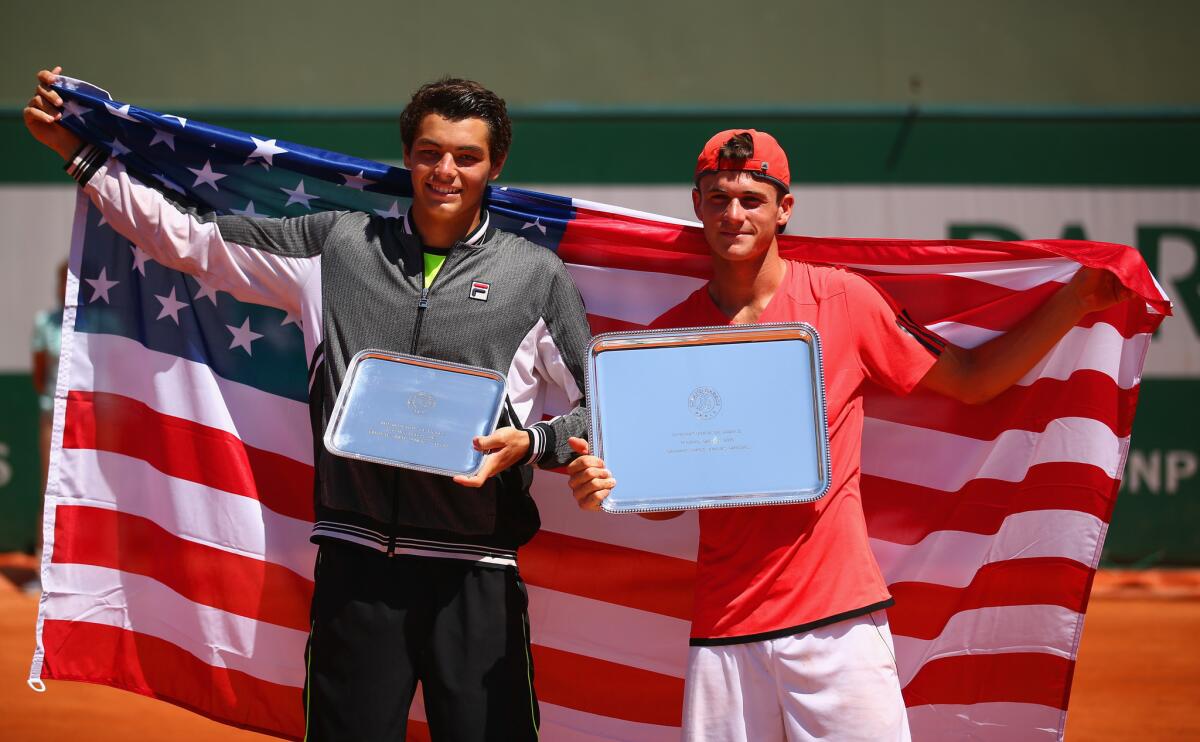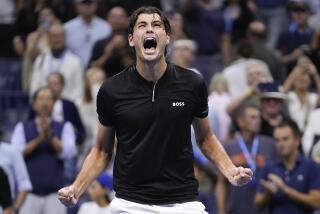Column: At 17, Taylor Fritz could be the next big thing in American men’s tennis

Runner up Taylor Fritz (left) and winner Tommy Paul pose with their trophies after their French Open Boys’ Singles Final match in June.
- Share via
from LONDON — Nov. 1, 2003, is notable in the annals of U.S. Tennis. That’s the last time a male tennis player claiming residence in one of the 50 states was elevated in the rankings to No. 1 in the world.
That player, Andy Roddick, won the U.S. Open that year. Since then, the number of male players claiming residence in one of the 50 states, who has won a major tournament, stands at zero. None, zilch.
Roddick is here at Wimbledon, doing what all former great American tennis players do these days. Talk.
He is good at it, glib and articulate; so good, that during a BBC telecast Wednesday, sitting at a table with John McEnroe, he was actually able to get in a sentence or two. In the world of tennis broadcasting, that’s a 140-mph ace.
Tennis remains a sport less hung up on nationalism than most, unless you are a Brit and Andy Murray is on court. If you like Roger Federer and you’re not Swiss, that doesn’t sway your enthusiasm. Same with Rafael Nadal, Novak Djokovic, Murray and several more.
But it can’t be ignored that the United States was once home to the likes of Pete Sampras, Andre Agassi, Jim Courier, Michael Chang, Arthur Ashe, Jimmy Connors and Stan Smith. Oh yes, also that McEnroe guy.
Now, men’s tennis in the U.S. appears to be a legacy lost. Sorry if you have heard this before — about John Isner, Donald Young, Sam Querrey and others — but there is hope on the horizon.
His name is Taylor Fritz. He is 17 years old. He comes from Rancho Santa Fe, Calif., and is the top-ranked junior player in the world. He is seeded No. 1 here and has been gobbling up the competition in the Wimbledon juniors as if it were a Pac-Man game.
Fritz stands 6 feet 4 and weighs 184 pounds. He looks about two inches taller and 20 pounds lighter. He serves in the high 120s consistently and his father and coach, Guy Fritz, says that his top range at the moment is “around 138.”
He attacks fearlessly and has a two-handed backhand that should be outlawed. He hits it with the confidence the rest of us have when we put our key in the ignition. We assume an engine vroom, he assumes a winner.
No rags-to-riches tale here. No rags, period.
His mother is Kathy May, a highly accomplished player, once ranked No. 10, with three Grand Slam quarterfinals on her resume. She comes from the family that started the May Company stores.
Guy Fritz is a former tour player himself, who teaches the game to elite players, including CoCo Vandeweghe, on a court in his Rancho Santa Fe backyard.
Despite all the tennis pedigree, both parents say they are taken aback by how good Taylor is, and how fast he has become so.
“When he was 12 and playing in tournaments, I knew he was good, really special,” Guy says, “but not so good that he’d be No. 1 in the world juniors.”
Kathy says, “I remember when he was 8, how focused he was. He knew the score, always had his head in the game. Unusual for an 8-year-old.”
These are not pushy parents. They are here to guide and root. You sense no desire to ride their child to fame and fortune, as is often the case. Certainly, fortune is not an issue.
Instead, this Wimbledon junior tournament may bring a family crisis: Should Taylor turn pro now, or next summer, after a year at USC?
“If he wins the Wimbledon juniors, it’s going to be tough holding him back,” says Guy, who wants his son to spend a year at USC, work out daily in the Trojans facilities to get bigger and stronger, and play a college season before heading into the scary world of pro tennis next summer.
“The average age of men players breaking into the top 100,” says Guy, “is 27.”
Kathy seems to be open to more discussion. Moms have tougher times saying no to sons.
Currently, Taylor is very clear on his intentions. Having made a verbal commitment to USC’s tennis coach, Peter Smith, eight or nine months ago, he now dismisses college plans.
He is asked, USC or UCLA?
“SC, but that’s not gonna happen,” he says, as he walks briskly from a 6-3, 6-2 first-round victory in a match he said was “disappointing” in describing his level of play.
He attended Torrey Pines High. Now he takes private, on-line courses. He has already won a main-draw pro match, beating No. 66 Pablo Carreno Busta of Spain at Nottingham two weeks ago. He lost the French Open junior final in three sets, and now is excelling on Wimbledon’s outside courts, within a stone’s throw of the legendary and ivy-covered Centre Court.
A half-dozen agents hover around his every match. His body seems on the verge of growing into his strokes. The parental stability is there, even if he might be running when they want him to jog. At best, he is a couple of years away from the big courts and late appearances in the big tournaments.
But the promise seems unmistakable, and we’ll know for sure when McEnroe tells us.
Twitter: @DwyreLATimes
More to Read
Go beyond the scoreboard
Get the latest on L.A.'s teams in the daily Sports Report newsletter.
You may occasionally receive promotional content from the Los Angeles Times.











